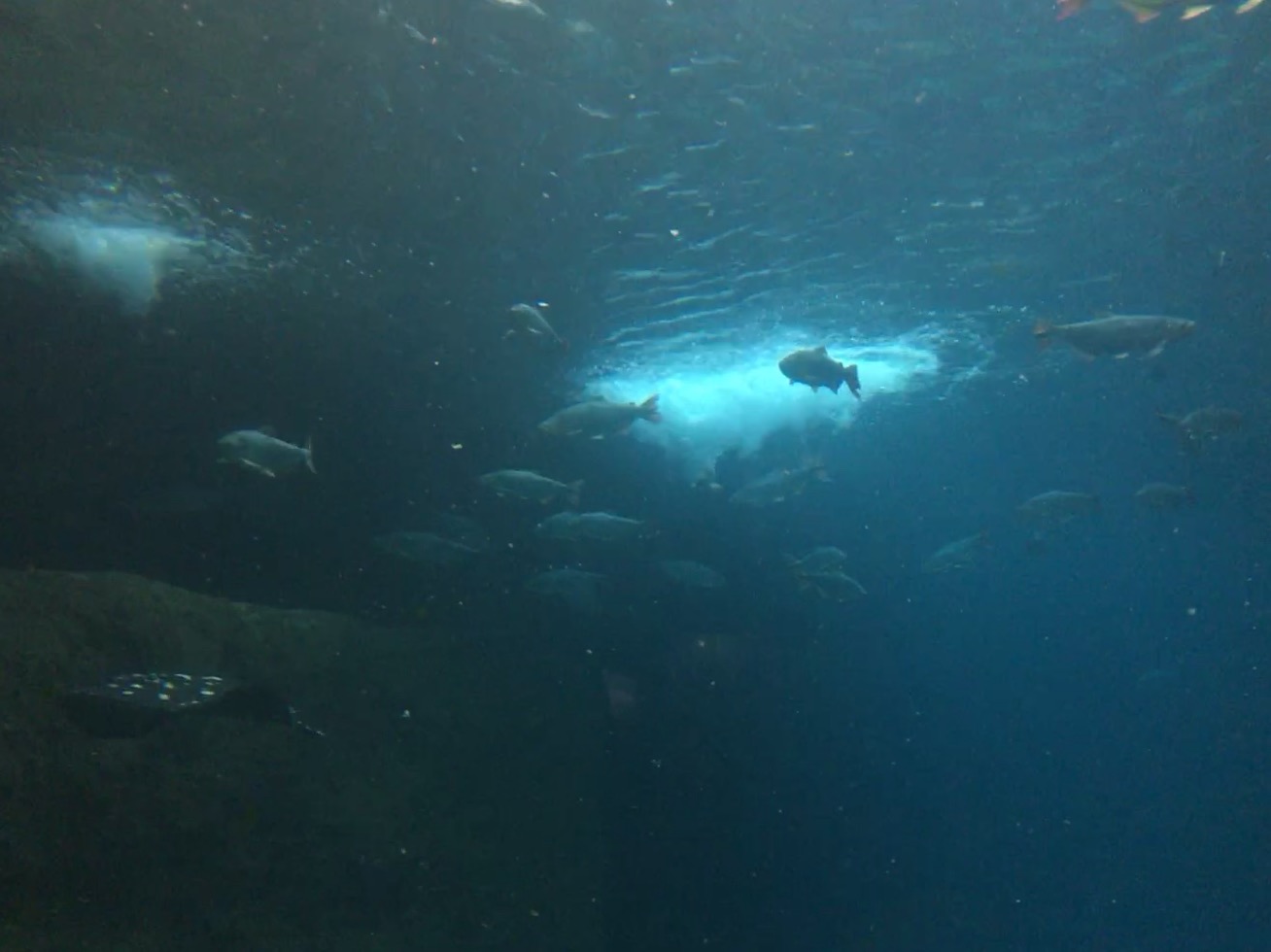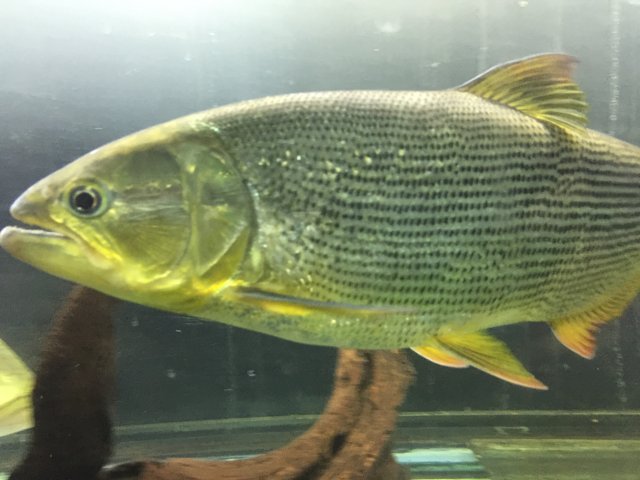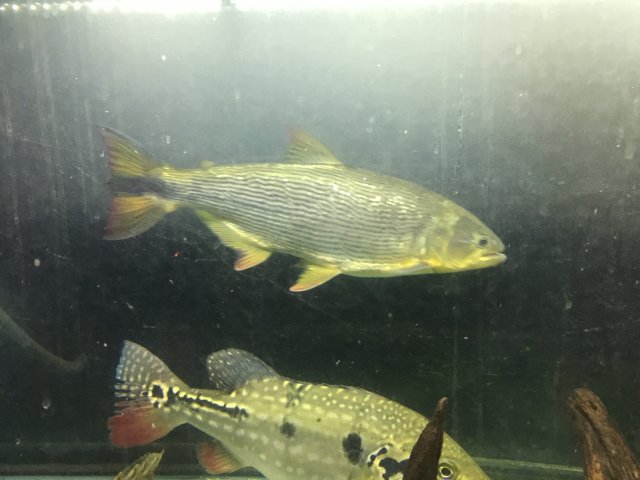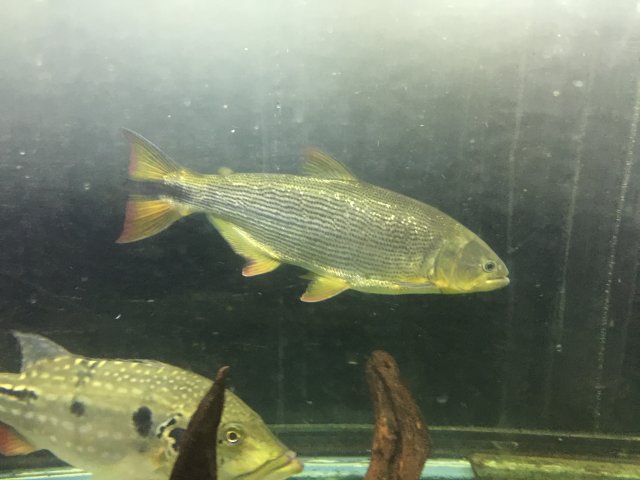We are under the impression that Brasiliensis is rarely imported and what is typically offered to hobbyists is farm raised Franciscanus.......
IS there indeed a solid 100% way to tell the difference between the 2 species? I'm under the impression even counting scales can be inconclusive as some numbers overlap into each species?
I've been keeping these things over the years but I have never grown one to what I would consider BIG. Maybe you can tell what I'm doing wrong? They grow fast when small slow around a foot or 14" then appetite seems to get finicky and growth is slow after. Biggest i've ever raised is probably 18-20" neighborhood. 10x4x2.5 tank should be capable of growing a larger fish then that I'd think......
Not sure if this will work but
here's the link to the formal description of S. fransiscanus. Relevant details quoted below:
"Diagnosis. Salminus franciscanus can be diagnosed from all Salminus species, except S. brasiliensis, by the presence of a second dentary tooth in the outer tooth series that is considerably larger than the remaining teeth (vs. second dentary teeth only slightly larger than remaining teeth in S. affinis and S. hilarii). Salminus franciscanus can be additionally diagnosed from S. affinis by the absence of the dark post-orbital stripe that is characteristic from the latter species. Salminus franciscanus can be diagnosed from S. brasiliensis in possessing much lower scale counts, i.e., lateral line (68-82, modally 77 scales, vs. vs. 79-102, modally 96), horizontal between dorsal-fin origin and lateral line (11-14, modally 12, vs. 14-18, modally 16) and horizontal between lateral line and pelvic-fin insertion (6-8, modally 6, vs. 6-9, modally 8). In spite of the great overlap, Salminus franciscanus has generally more lateral line (68-82, modally 77 scales, vs. 54-72, modally 65-66), horizontal between dorsal-fin origin and lateral line (11-14, modally 12, vs. 9-12, modally 10), and horizontal between lateral line and pelvic-fin insertion (6-8, modally 6, vs. 4-7, modally 5), scales, when compared to the sympatric S. hilarii. In life, Salminus franciscanus can also be distinguished from S. hilarii by the presence of golden coloration mainly over the facial bones and pectoral girdle (vs. facial bones and pectoral girdle silvery). See under "Remarks", below, for more details on the diagnosis of Salminus franciscanus regarding its congeners."
Also within the Discussion section
"
Given the pronounced similarity among the species of Salminus, the distinctness of S. franciscanus and its congeners was repeatedly discussed in the sparse literature dealing with the taxonomy of the genus. Lütken (1875b, 2001) was the first author to propose a possible diagnosis between what is herein described as Salminus franciscanus (his S. cuvieri) and the sympatric S. hilarii. Lütken (1875b, 2001), after presenting a thorough morphological comparison between both species, concluded that only scales counts (higher in Salminus franciscanus) and a "difference in teeth size", presumably a reference to the great development of the second dentary tooth in S. franciscanus, distinguished the two species. Lütken (1875b, 2001) warned that these differential characters should be considered as tentative since he examined only three specimens of Salminus franciscanus (one of which a skin) and a single individual of S. hilarii, that he considered a juvenile. That individual measured 81/4 Danish inches ( = 21.6 cm) which would make it rather an adult of this relatively small-sized species of Salminus. Interestingly, Lütken (1875b, 2001) was the first author to notice the discrepancy between the descriptions of Hydrocyon brevidens by Cuvier (1819) and Salminus cuvieri by Valenciennes (in Cuvier & Valenciennes, 1850). He noted that "Salminus cuvieri Val. cannot be the Hydrocyon brevidens from Cuvier, who, according to the original description, possess more than 100 lateral line scales... being, consequently, more probably identical to the species that inhabits the La Plata River" (Lütken, 2001: 121; our translation). Obviously, Lütken (1875b, 2001) was unaware of the fact that the same specimen was used in the description of both species and that the difference in lateral line counts was due to a mistake by Valenciennes. Steindachner (1880: 80), when describing Salminus affinis, considered this species very similar to S. franciscanus (his S. cuvieri; hence the epithet "affinis"), from which it was said to be diagnosable only by the presence, in the latter species, of a more robust and developed "canine" tooth ("Hundszahne") ( = second dentary tooth) and by the development, in S. franciscanus, of the central caudal-fin rays into a distal projection. As noted under "Diagnosis" and below, both are in fact valid characters to diagnose these species. Steindachner (1880: 82-83) compared Salminus franciscanus with S. hilarii, but considered them probably synonymous, believing that specimens of S. hilarii were juveniles (thus, ignoring Lütken's observations, who has compared specimens from both species of the same size). Curiously, Steindachner (1880) used Salminus cuvieri for S. franciscanus, and, in the same paper, S. brevidens for the species from the La Plata basin (= S. brasiliensis). Günther (1864) was the first author to employ Salminus brevidens for S. franciscanus, a practice that prevailed in the literature from Eigenmann (1916) up to Britski et al. (1984). Finally, Géry & Lauzanne (1990) noted that Hydrocynus brasiliensis is the older name and consequently has priority over its objective synonyms Hydrocyon brevidens and Salminus cuvieri, and more pertinently that the name should be applied to the Salminus species from the La Plata basin, rather than to one of the species from the rio São Francisco basin.
The more striking diagnostic feature of Salminus franciscanus when compared to its congeners is the great development of the second dentary tooth, which is considerably larger than the remaining dentary teeth. This feature, already reported for the species by previous authors (Lütken, 1875b, 2001; Steindachner, 1880; Géry & Lauzanne, 1990), is not, however, exclusive to Salminus franciscanus, since S. brasiliensis and, to a lesser extent, some examined specimens of S. affinis also possess a second dentary tooth distinctly larger than the remaing teeth. However, unlike Salminus franciscanus, which retain a second dentary tooth considerably larger than the remaining teeth throughout its development, in S. brasiliensis the disparity in size between this tooth and the remaining dentary teeth present a ontogenetic change. Individuals larger than 350 mm SL of the latter species possess this tooth similar in size to the remaining dentary teeth. The great development of the second dentary tooth is the better clue to diagnose Salminus franciscanus from the sympatric S. hilarii, which, inasmuch as possessing a second dentary tooth slightly larger than the remaining teeth in small specimens (< 150 mm SL), never possess it as developed as S. franciscanus. Another interesting feature present in Salminus franciscanus is the great development of the extension of the central caudal-fin extension, throughout of which extends the laterosensory tube. Salminus franciscanus has a well-developed central caudal-fin extension, which extends 1/3 or even ½ beyond primary margin of fin. Salminus brasiliensis is the only congener to possess an well-developed central caudal-fin extension, which, however, is not as well developed as the one observed in S. franciscanus. In Salminus hilarii, the central caudal-fin extension is very short, being apparent only as a small convexity on the distal portion of the caudal fin, while S. affinis apparently does not possess any development of the median caudal-fin rays beyond the primary margin of the fin."
Up until recently S. brasiliensis was not aquacultured but these animals are now actively being produced. Under IBAMA(Brazil Fish and Wildlife) the genus is blacklisted for export for the hobby, so without permits they have to be coming from another country(not sure where). I'll have to do some digging with my importer.
For all: Just read that they reach sexual maturity around 36"TL so that may account for the current muted coloration.




















